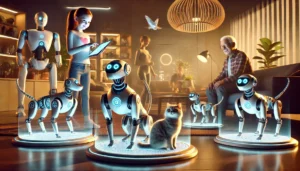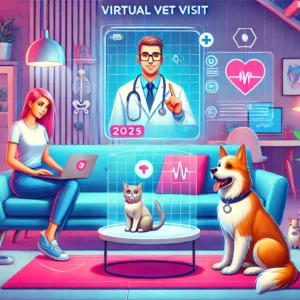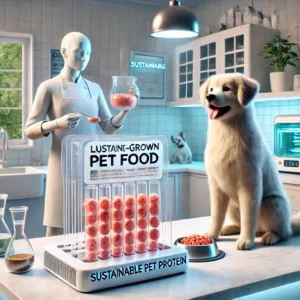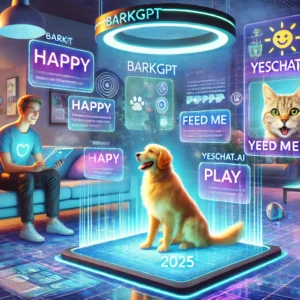
Picture this: it’s 2025, and you’re coming home from a long day at work. Instead of being greeted by a regular tail-wagging dog or a purring cat, you’re met with a sleek, metallic “pet” that lights up and rolls toward you on tiny wheels, making soft digital chirps. Sound like science fiction? Not anymore. Robotic pet companions have become a booming trend—part of a new era in which technology and companionship intertwine in unexpected ways.
In this article, we’ll explore why these mechanical critters have captured our hearts and wallets, diving into the latest political debates, government initiatives, scientific research, celebrity endorsements, and generational opinions that drive their popularity. If you’re curious about how a robotic dog (or cat, or bird-like contraption) might fit into your life—whether you’re a busy city dweller, a tech-savvy teen, or a senior citizen looking for some comfort—this deep dive is for you.
What Exactly Are Robotic Pet Companions?
Robotic pet companions are artificially intelligent machines designed to mimic the behavior and emotional warmth of real animals. They come in various shapes and sizes—some closely resembling traditional dogs or cats, while others look more futuristic, complete with LED eyes or metallic fur. Usually equipped with sensors, cameras, and responsive software, these pets can detect touch, recognize faces, and even learn from day-to-day interactions with their human owners.
Unlike typical AI toys of the past, these new-generation robotic companions offer a more lifelike experience. Some can bark, wag synthetic tails, or meow softly. Others hum with gentle vibrations instead of purring. Manufacturers emphasize emotional connection, highlighting that these robo-creatures can understand voice commands, respond to basic instructions, and adapt to patterns in your daily routine. Essentially, they’re part of a rapidly growing market that merges artificial intelligence with emotional well-being.
From Prototype to Pet Store Shelves
Not so long ago, robotic pets were clunky prototypes found in tech labs, the stuff of science fairs and imaginative speculation. Fast forward to 2025, and major electronics brands are launching lines of robotic companions in select pet stores and tech outlets worldwide. According to recent industry reports, global sales of these mechanical buddies have quadrupled in the last two years, with many families seeking an alternative to the responsibilities tied to real pet ownership.
Why the sudden surge? Several factors are at play:
- Busy Lifestyles
- Younger professionals living in cramped apartments can’t always care for a real dog or cat.
- Robotic pets require no litter box or early-morning walks, yet still offer a semblance of companionship.
- Allergies and Health Concerns
- Some households have members who are allergic to fur.
- Robo-pets bypass these issues entirely, appealing to those who love animals but can’t coexist with them physically.
- Cost-Effectiveness
- While the initial price tag can be steep, owners don’t face vet bills or daily feeding costs.
- Hardware repairs can be expensive, but warranties often cover routine maintenance.
- Nostalgia Meets Innovation
- Robotic pets tap into the same emotional bond we have with real animals, yet they feel fresh and futuristic.
Government Notes and Regulatory Landscape
With the rising demand for robotic pet companions, governments around the globe are taking notice. In some countries, like Japan and South Korea, local authorities offer tax incentives to tech firms investing in advanced AI-driven companion pets for elderly care facilities. They argue that mechanical pets could ease the burden on healthcare systems by providing emotional support to seniors.
Meanwhile, in the United States, the Federal Trade Commission (FTC) and the Food and Drug Administration (FDA) have stepped in to monitor how these robots impact mental health and emotional well-being. Government officials want to ensure that robotic pets marketed as “therapeutic” or “emotional support” devices meet certain standards. They’re also keeping an eye on data privacy, as some robotic pets store user data to learn preferences and behaviors.
Global Summits on AI and Robotics now occasionally dedicate sessions to this phenomenon. Politicians address concerns about consumer protection, asking if lifelike responses could be manipulative or exploit vulnerabilities in lonely individuals. Striking a balance between innovation and ethical guidelines is the main challenge.
Political Debates and Policy Talk
Unsurprisingly, the rise of robotic pets has sparked heated political discourse. Some critics argue that robotic animals could undermine real pet adoption from shelters. They fear that a generation raised on digital companionship might overlook the reality of living, breathing animals in need of homes.
Environmental policy also enters the conversation. Legislators question whether manufacturing robotic pets contributes to electronic waste. Proponents counter that fewer real pets could mean decreased environmental impact from factory farming of pet food. In the European Union, a few parliamentary debates have addressed the possibility of an “eco-label” for robotic pets, indicating whether their materials and production processes align with sustainability goals.
Another controversial aspect is labor displacement. A handful of political figures suggest that widespread use of robotic therapy pets in senior living communities might reduce the need for certain caregiving roles. Proponents claim it’s more about supplementation than replacement, but the debate rages on—especially as the world grapples with AI’s broader impact on the workforce.
Research Labs and Scientists’ Perspectives
Robotic pet companions didn’t appear out of thin air. Top research labs—like MIT’s Media Lab, the University of Tokyo’s robotics department, and private outfits like Boston Dynamics—have spent years refining robotics for domestic use. Their focus extends beyond making pets that are “cute and cuddly.” They examine how humans bond with machines on an emotional level.
According to Dr. Eliza Harmon, a lead roboticist at a California-based AI firm:
“Our studies indicate that people respond to robotic pets with real empathy if the design incorporates natural movements, lifelike vocalizations, and consistent behavioral patterns. We see genuine emotional engagement in about 70% of participants, especially among children and seniors.”
Furthermore, psychologists collaborate with engineers to measure how human brain chemistry responds to robotic stimuli. Early findings suggest that individuals who frequently interact with these robo-pets experience an uptick in oxytocin levels—akin to the “love hormone” surge we get when hugging real animals or family members.
Celebrity Endorsements and Pop Culture Spotlight
Curious about what the A-listers think? It’s 2025, so, of course, celebrities are leading the charge in this new wave of techno-pet mania. Pop star Billie Eilish showcased her robotic cat on Instagram, describing it as “the perfect companion on tour.” Meanwhile, actor Ryan Reynolds humorously named his mechanical dog “Gizmo,” sharing comedic clips of it chasing a futuristic squeaky ball around the living room.
Influencers on TikTok quickly hopped on the trend, launching viral challenges where they dress up their robotic companions in tiny outfits or program them to “dance” to popular songs. These videos accumulate millions of views, contributing to the mainstream acceptance of mechanical pets as legitimate household companions.
Seniors and Robotic Pets: A Blossoming Bond
Though younger crowds often dominate the conversation around cutting-edge technology, older individuals are also finding solace in robotic pet companions. Many seniors live alone, far from family or in assisted living communities where animals might not be allowed. These lifelike mechanical pets offer consistent companionship without the hassle of daily feeding or walks.
- Reduced Loneliness: Seniors report feeling less isolated when they can interact with a robo-pet that remembers their name or “nudges” them for attention.
- Simple Maintenance: There’s no cat litter to scoop or dog fur to vacuum, which is a relief for those with mobility issues.
- Therapeutic Benefits: Some studies suggest that robotic pets lower anxiety and help with mild cognitive issues, particularly in individuals with early-stage dementia.
People often recall the story of a 92-year-old woman in Florida whose robotic dog sang lullabies in a soft, digital bark. It might sound whimsical, but for her, it was a source of genuine comfort.
Younger Generations and the Allure of Tech Pets
On the flip side, many teens and young adults grew up with smartphones practically glued to their hands. It’s hardly surprising they’d gravitate toward a “living” piece of tech they can cuddle. Younger folks especially enjoy the customizability of these mechanical pals—personalizing their color patterns, voice settings, and “behaviors.”
For instance, some robotic dogs can be programmed to prefer certain digital “treats,” like a phone-based app token. Eager for likes and shares, these pet owners post extensively about unlocking new “tricks” or teaching their robo-dogs to respond to TikTok dance moves. While older generations might find this cringe-worthy, it’s a form of digital-age creativity and expression for the youth.
Moreover, younger people often approach real pet adoption with caution due to uncertain housing or job prospects. A robotic pet companion can be a stepping stone—fulfilling some emotional needs without the heavier, long-term responsibilities tied to live animals.
Global Business, Earnings, and Revenue Boom
Now, let’s talk about the money side. The global market for robotic pet companions is exploding, with estimates suggesting a market value surpassing $10 billion by 2026. The Asia-Pacific region leads the charge, fueled by tech-savvy consumers in Japan, China, and South Korea. North America isn’t far behind, especially as major retailers start to stock advanced robo-pets.
Revenue Streams
- Hardware Sales: Robots themselves can fetch anywhere from $500 to $5,000, depending on complexity and brand.
- Subscription Services: Certain models require monthly software updates or advanced AI upgrades, akin to phone app subscriptions.
- Accessories and Customizations: Robo-pet outfits, digital collars, or extra “personality” packs can be purchased to enhance your mechanical buddy’s behavior.
Large tech conglomerates see these robotic pets as a gateway to bigger things—smart home integration, data analytics, even healthcare applications. Meanwhile, smaller startups focus on niche markets, like robo-birds for those who adore parrot-like companionship without the mess, or mechanical cats for senior centers.
Social Implications and Ethical Debates
You can’t introduce something this innovative without raising eyebrows. Ethical questions abound:
- Emotional Dependency: Critics ask whether these mechanical pets might hamper genuine human connection. If a robo-pet can fill emotional voids, do we risk isolating ourselves from real social interactions?
- Replacement vs. Supplement: Traditional pet owners feel uneasy about the notion of replacing real animals with machines. Animal welfare groups, on the other hand, highlight that fewer real pets could mean less abandonment or mistreatment.
- Data Privacy: Many advanced robotic pets store data in the cloud to “learn” from owners. Who owns that data? Could it be sold to advertisers?
- Social Inequity: Top-tier models remain pricey, so is this simply another luxury item out of reach for low-income populations? Or could affordable versions eventually democratize digital companionship?
Society appears split—some see endless potential for comfort and convenience, while others caution that we might lose something fundamentally human if we rely too heavily on machine “love.”
Real-Life Stories and Anecdotes
Let’s pivot to a few real-life accounts that reveal just how significant these robotic relationships can be:
- Case #1: A single father in Seattle gifted his 10-year-old daughter a robo-cat after discovering her severe allergies to real felines. She named it “Silverpaws” and quickly formed a bond, brushing its synthetic fur each night. Despite not being a living creature, Silverpaws helped her cope with loneliness after her mother’s passing.
- Case #2: In a rural Canadian nursing home, an AI-driven dog named “Rusty” sits in the common area. Residents with dementia often gather around, petting Rusty’s golden-brown plastic coat. Caretakers say it provides a sense of calm, and some seniors even reminisce about pets they once had.
- Case #3: A tech entrepreneur in Singapore built her own open-source robotic companion, a small rolling hedgehog with LED quills. She shares design files online, enabling hobbyists around the world to build personal versions. This fosters an open community where people exchange upgrades and software patches.
Such stories illustrate the broad appeal and nuanced roles these robotic pets play in people’s lives, from comfort to creativity.
Potential Drawbacks and Criticisms
No trend is without its pitfalls. While robotic pet companions can offer emotional benefits, critics maintain a list of concerns:
- High Initial Costs: The price tag on some advanced models can be prohibitive, limiting accessibility.
- Maintenance Hassles: While you might not need to feed a robo-pet, repairs can be time-consuming and expensive if a sensor or motor fails.
- Lack of Genuine Interaction: Purists argue that no matter how advanced the AI, a robotic pet can’t replicate the genuine unpredictability and warmth of a living animal.
- Over-Reliance: Some mental health professionals worry that individuals might use robo-pets as a crutch, avoiding real-world socializing or the responsibilities of caring for an actual creature.
Still, none of these criticisms have slowed the market’s rapid growth. In many ways, the conversation mirrors historical debates on everything from cell phones to social media: is new technology connecting us or isolating us?
Tips for Choosing the Right Robotic Pet
If you’re intrigued by this futuristic phenomenon, here are a few things to consider before hitting the “Buy” button:
- Budget
- Prices range widely. Assess your financial comfort level, including any ongoing software or maintenance fees.
- Features
- Do you want advanced AI that recognizes faces, or is a simpler version sufficient? Some robotic pets are essentially fancy remote-controlled toys, while others can truly “learn” and adapt.
- Aesthetic and Size
- If you live in a small apartment, a cat-sized companion or smaller might be ideal. Larger, dog-like robots can be cumbersome in tight spaces.
- Purpose
- Is it for companionship, therapy, or child entertainment? Knowing why you want a robo-pet will help narrow down the options.
- Reviews and Warranties
- Always read reviews from real users and check warranty policies. Regular updates and customer support can be crucial.
Frequently Asked Questions (FAQs)
Q: Are robotic pets safe for children?
A: Generally, yes. Most models undergo safety tests. However, always check age recommendations, as small parts or advanced interactive features might require adult supervision.
Q: Can a robotic pet help with loneliness or anxiety?
A: Studies indicate they can, particularly for seniors and individuals unable to care for live animals. Still, a robotic pet isn’t a substitute for professional mental health support.
Q: Do I need Wi-Fi or a smartphone app to operate them?
A: Some basic models run offline, but advanced companions typically offer smartphone connectivity for updates and personalization.
Q: How long do the batteries last?
A: It varies. Many robotic dogs can run for 4-6 hours on a full charge, while simpler models might last even longer.
Q: What if the robot malfunctions?
A: Check the manufacturer’s warranty. Some brands have repair centers or mail-in services. Others provide replacement parts you can install yourself.
Final Thoughts and a Look Ahead
Love them or hate them, robotic pet companions are here to stay. And as AI technology continues to leap forward, these mechanical sidekicks will only become more lifelike—capable of reading human emotions, engaging in playful banter, and even forging connections with smart home devices. Governments are sculpting new regulations, researchers are expanding the boundaries of machine-human empathy, and consumers across the age spectrum are forging surprising bonds with electronic critters.
Sure, they might not replace the warmth of a wagging tail or a gentle purr from a real animal. But for millions of people—whether due to allergies, apartment restrictions, or an insatiable thirst for futuristic innovation—these robo-pets fill a vital niche. Feeling curious? Explore the current offerings, read user reviews, or even attend a demo to see if a robotic companion resonates with you or your loved ones.
Ready to delve deeper? You can check out our other articles on emerging pet technologies or subscribe to our newsletter for the latest reviews of new robo-pet releases. The choice is yours, but one thing’s certain: we’ve stepped into a brand-new era of pet ownership—one where metal and circuitry combine to bring emotional comfort, interactive play, and a slice of sci-fi magic right into your living room.




